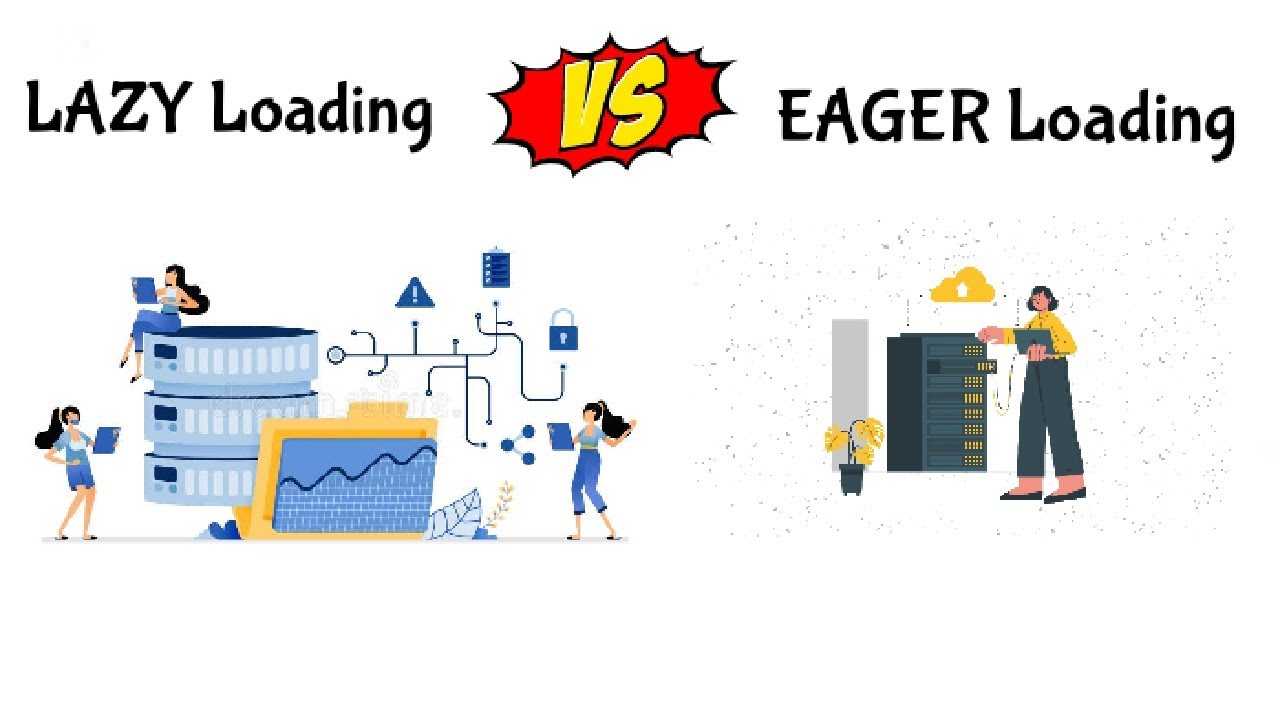The Difference between Eager Loading vs Lazy Loading


The comparison of Eager Loading vs Lazy Loading is a topic of significant importance. Understanding what Eager Loading and Lazy Loading are essential. In this article, we will break down what Eager Loading and Lazy Loading are, their benefits, and when to use each. This guide helps you make informed choices in your development projects, ensuring you leverage the right strategy.
Definition
Eager Loading is a pre-emptive approach to data handling and resource management. In this strategy, an application loads the required data and resources during its initial load phase. This method is akin to a “bulk purchase,” where everything you might need is acquired in one go, regardless of whether you will use all of it immediately or not.

Eager Loading
Benefits
Definition
Lazy Loading is a deferred loading approach. It strategically delays the Loading of resources and data until they are required. This method is like shopping for groceries as and when you need them, rather than stocking up everything in one go.

Lazy Loading
Benefits
Understanding the difference between Lazy Loading and Eager Loading is key to optimizing performance and user experience in various applications. Here are the main distinctions:
| Aspect | Lazy Loading | Eager Loading |
| Resource Initialization Timing | Delays initialization until needed, loading resources like images or data only when accessed or a condition is met. | Initializes or loads resources as soon as code is executed or page is loaded, regardless of immediate need. |
| Impact on Performance | Reduces initial load times, ideal for speed and responsiveness, but may introduce delay when accessing resources for the first time. | Ensures immediate availability of resources, smoother post-load experience, but longer initial load times. |
| Bandwidth and Memory Usage | More efficient, loading only required resources, beneficial for mobile users or limited bandwidth. | Consumes more bandwidth and memory upfront by loading all resources, which is less efficient for limited resources. |
| Application Scenarios | Suited for applications with many features/content, ideal for mobile devices or varying network conditions. | Appropriate for smaller applications where all resources are essential from the start, like certain desktop applications. |
| Complexity and Maintenance | More complex logic for on-demand loading, increasing code maintenance complexity. | Simpler to implement, no additional loading logic, but may need optimization for initial resource load. |
| User Experience | Enhances experience by reducing initial load times, but may delay accessing features/content for the first time. | Consistent experience post-initial load, all features available, but longer initial load times may impact engagement. |
Check out our in-depth comparison and guide:
Eager Loading, the strategy of loading all necessary resources upfront, is particularly effective in certain scenarios:

Eager Loading vs Lazy Loading
Conversely, Lazy Loading, which involves loading resources on-demand, is more suitable in different scenarios:
Choosing between Eager Loading and Lazy Loading is crucial in shaping your application’s performance and user experience. Eager Loading offers immediate resource availability, ideal for smaller, predictable applications, while Lazy Loading enhances initial load times and efficiency, suitable for content-rich or mobile platforms.
Navigating these strategies can be challenging, but you don’t have to do it alone. TECHVIFY tailors these approaches to fit your needs, ensuring your application meets and exceeds user expectations. Contact TECHVIFY today for expert guidance and solutions.


Table of ContentsI. Understanding Eager Loading vs Lazy Loading1. Eager Loading2. Lazy Loading II. Key Differences Between Lazy Loading and Eager LoadingIII. Eager Loading vs Lazy Loading, Which One to Choose?1. When to Use Eager Loading2. When to Use Lazy LoadingConclusion Technological advancements are paving new paths for companies across different sectors, and the logistics industry is no exception. According to a survey by Gartner, 87% of supply chain professionals plan to invest in enhancing the resilience of their platforms. Logistics encompasses a broad and complex array of processes that demand the utmost precision and continuous optimization. Companies can automate and…
26 July, 2024

Table of ContentsI. Understanding Eager Loading vs Lazy Loading1. Eager Loading2. Lazy Loading II. Key Differences Between Lazy Loading and Eager LoadingIII. Eager Loading vs Lazy Loading, Which One to Choose?1. When to Use Eager Loading2. When to Use Lazy LoadingConclusion The technology sector is advancing at an unprecedented pace, and the HR landscape is evolving right alongside it. To attract top talent, HR professionals and organizations need to stay ahead of emerging technology hiring trends. This year, we are witnessing significant shifts in hiring practices that will redefine our understanding of the future workforce. According to a Microsoft study, the…
25 July, 2024

Table of ContentsI. Understanding Eager Loading vs Lazy Loading1. Eager Loading2. Lazy Loading II. Key Differences Between Lazy Loading and Eager LoadingIII. Eager Loading vs Lazy Loading, Which One to Choose?1. When to Use Eager Loading2. When to Use Lazy LoadingConclusion Customized software plays a major role in managing various tasks within the telecom industry. It is essential for allocating numbers to subscribers and managing networks through optimized and AI-enabled routing protocols. Additionally, it aids in detecting fraud with intelligent telecom software development solutions and maintaining detailed subscriber profiles, including comprehensive call recording reports. I. A Quick Look into the Telecommunication…
24 July, 2024


Thank you for your interest in TECHVIFY Software.
Speed-up your projects with high skilled software engineers and developers.
By clicking the Submit button, I confirm that I have read and agree to our Privacy Policy